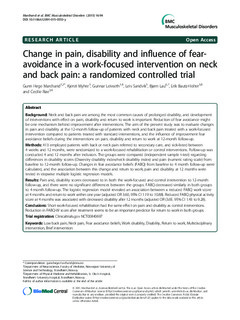Change in pain, disability and influence of fear-avoidance in a work-focused intervention on neck and back pain: a randomized controlled trial
Marchand, Gunn Hege; Myhre, Kjersti; Leivseth, Gunnar; Sandvik, Leiv; Lau, Bjørn; Bautz-Holter, Erik; Røe, Cecilie
Journal article, Peer reviewed
Permanent lenke
http://hdl.handle.net/11250/286377Utgivelsesdato
2015Metadata
Vis full innførselSamlinger
Sammendrag
Background: Neck and back pain are among the most common causes of prolonged disability, and development
of interventions with effect on pain, disability and return to work is important. Reduction of fear avoidance might
be one mechanism behind improvement after interventions. The aim of the present study was to evaluate changes
in pain and disability at the 12-month follow-up of patients with neck and back pain treated with a work-focused
intervention compared to patients treated with standard interventions, and the influence of improvement fear
avoidance beliefs during the interventions on pain, disability and return to work at 12-month follow-up.
Methods: 413 employed patients with back or neck pain referred to secondary care, and sick-listed between
4 weeks and 12 months, were randomized to a work-focused rehabilitation or control interventions. Follow-up was
conducted 4 and 12 months after inclusion. The groups were compared (independent sample t-test) regarding
differences in disability scores (Oswestry disability index/neck disability index) and pain (numeric rating scale) from
baseline to 12-month follow-up. Changes in fear avoidance beliefs (FABQ) from baseline to 4 month follow-up were
calculated, and the association between this change and return to work, pain and disability at 12 months were
tested in stepwise multiple logistic regression models.
Results: Pain and, disability scores decreased to in both the work-focused and control intervention to 12-month
follow-up, and there were no significant differences between the groups. FABQ decreased similarly in both groups
to 4 month follow-up. The logistic regression model revealed an association between a reduced FABQ work score
at 4 months and return to work within one year (adjusted OR 3.60, 95% CI 1.19 to 10.88). Reduced FABQ physical activity
score at 4 months was associated with decreased disability after 12 months (adjusted OR (3.65. 95% CI 1.43 to 9.28).
Conclusions: Short work-focused rehabilitation had the same effect on pain and disability as control interventions.
Reduction in FABQ-W score after treatment seems to be an important predictor for return to work in both groups.
Trial registration: Clinicaltrials.gov NCT00840697
Keywords: Low back pain, Neck pain, Fear avoidance beliefs, Work disability, Disability, Return to work, Multidisciplinary
intervention, Brief intervention
